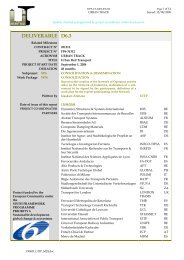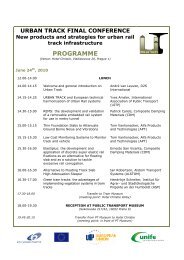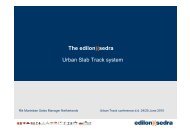DELIVERABLE 2.8 - urban track
DELIVERABLE 2.8 - urban track
DELIVERABLE 2.8 - urban track
You also want an ePaper? Increase the reach of your titles
YUMPU automatically turns print PDFs into web optimized ePapers that Google loves.
2.9. NEW DEVELOPMENTS<br />
D0208_STIB_M24.doc<br />
TIP5-CT-2006-031312 Page 21 of 44<br />
URBAN TRACK Issued: August 13, 2008<br />
Quality checked and approved by project co-ordinator André Van Leuven<br />
Corus is fully aware of the importance of the weld restoration coating process as it is significantly more<br />
cost effective that the renewal of embedded <strong>track</strong>s.<br />
The key requirements of the new system are:<br />
the use of steels with higher carbon content than grades 700/800 to reduce wear;<br />
a process for in situ restoration without destroying the surrounding jacket;<br />
restore the worn face with a more resistant wear coating resulting in a composite rail;<br />
repeated application of the coating process.<br />
A new submerged arch welding process was developed that uses a specifically formulated flux, a cored<br />
arc wire and flux powder.<br />
Steps of the process:<br />
1. Light grind cleaning of the worn face;<br />
2. Preconditioning with a novel “chill removal” treatment in the area to be restored;<br />
3. Weld deposition of the root pass;<br />
4. Weld deposition with subsequent passes until the worn portion has been restored;<br />
5. Deposition of a capping weld bead as a final sacrificial layer;<br />
6. Grinding to remove the sacrificial layer and to impart the desired gauge corner profile.<br />
The key to creating the hard weld is the pre-conditioning “chill removal” treatment, which results in:<br />
a crack free root pass of the weld deposit;<br />
a hard but tough tempered martensitic microstructure in all passes.<br />
The removal of the sacrificial last pass leaves a tough wear resistant surface<br />
A purposely designed welding unit achieved the following:<br />
10 to 12 m in a 4.5 hour <strong>track</strong> possession;<br />
Capability of restoring more than 10 mm;<br />
Preference to 6 mm wear.<br />
The process is under still under development and is applied in Sheffield.<br />
The following problems still need to be addressed:<br />
The “chill removal” process is difficult to execute on an embedded rail and needs enhancement.<br />
Currently the experience is limited to only one restoration on a rail.<br />
The conventional process can be repeated several times.<br />
The preference is to restore after 6 mm of wear whereas the conventional process can rebuild after up<br />
to 20 mm of wear and this can be repeated up to 6-8 times.<br />
The technique is not yet used on a wide scale: prototype evaluation is on going.








